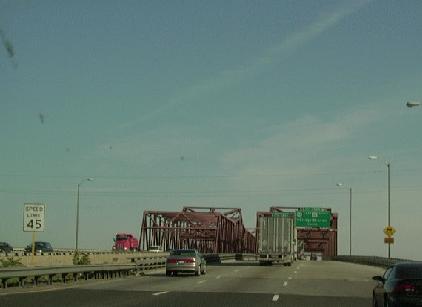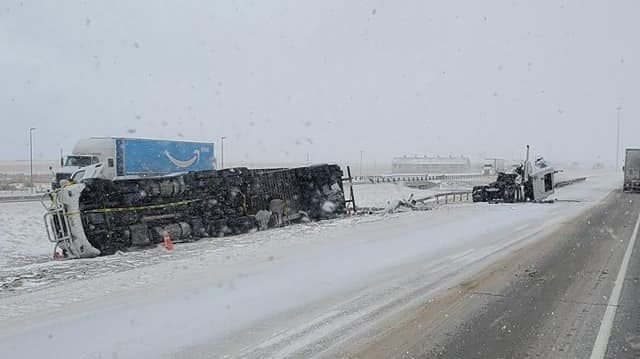This installment focuses on some interstate highways that are particularly treacherous for truckers. Many drivers avoid them whenever possible, especially during nasty weather. Here’s what they had to say.
Interstate 80 in northern Illinois
Interstate 80 in Joliet, Illinois, consists of dual bridges crossing the Des Plaines River. They were first constructed in 1965 and subsequently reconstructed in 1998. According to the I-80 Coalition, the dual bridges span 2,300 feet in length, carrying more than 85,000 vehicles a day. They provide a vital link for both local east-west mobility through Will County, and to the national freight system.
Brian Watt, a logistics executive at 1634 Co. in Sarasota, Florida, told FreightWaves that both superstructures have been rated by the state of Illinois as being in serious or critical condition.

“These two bridges on the I-80 artery at Joliet, Illinois, carry at least 12,000 commercial trucks (heavies) per day,” Watt said. “These two bridges have tight turns and steep grade approaches, relative to normal interstate approaches, which make truck navigation difficult in good conditions. Toss in notorious Chicago winter weather and things get downright interesting.”
The existing Des Plaines River Bridge structure is a truss bridge, which cannot be widened. The Illinois Department of Transportation (IDOT) plans to replace the bridges in the coming years.
Interstate 70 in Colorado
Winters can be wicked for truckers heading through the Colorado Rockies. Storms can produce feet of snowfall and wind gusts of 60-plus mph over mountain passes. More often than not, the worst conditions usually hit I-70 between Denver and Glenwood Springs. This includes the infamous Eisenhower Tunnel and Loveland Pass areas.
“My most unwanted highway to be on … I-70 over the Rocky Mountains into and out of Denver. It’s very regulated, as it should be,” trucker Wayne Cragg, from Laredo, Texas, told FreightWaves. “But dang, from September to May hold onto your baby wipes because your chains may help you descend or ascend that mountain pass in bad weather, your underwear will not.”
Colorado has some of the nation’s strictest chain laws for truckers.
Interstate 80 in Wyoming
Even on bright, sunny days, the winds along I-80 in Wyoming can send a trucker into a tumble or tailspin. This is especially true if they’re deadheading (hauling an empty van) or carrying a light load. Throw in a blizzard and it’s nearly impossible for drivers to safely make it through certain areas. Sections of I-80 often stay closed for 24 hours due to whiteout conditions.
Trucker Dan Roe, from Newburgh, Indiana, said this about hauling through this region: “Wyoming’s high winds … make it a very dangerous place. I’m glad I gave up going out there.”

Meteorologists at the National Weather Service (NWS) office in Cheyenne told FreightWaves that they issue an average of 35 to 40 high-wind warnings per year for their southeastern Wyoming counties. The bulk of the high-wind season spans from October to March, and the highest number of warnings is usually in January.
Interstate 26 in South Carolina
Known as South Carolina’s most dangerous road, I-26, one of 11 interstate highways in the state, has seen its share of accidents over the years. According to the latest South Carolina Department of Public Safety figures from 2018, I-26 ranked No. 1 in total number of traffic collisions (4,592) and fatal collisions (37), as well as serious injury collisions (44) and persons killed (39). Many of the accidents occurred on certain stretches of the road that have steep ditches and few guardrails. On many segments of I-26, average daily traffic has increased fivefold since the highway opened in the late 1960s.
“It’s awful. It’s not wide enough,” trucker Brett Elliott told Charleston’s The Post and Courier in 2018. Elliott said he had seen people die in accidents on I-26.
The stretch from Orangeburg to Charleston is particularly dangerous. SCDOT officials said 57 traffic deaths happened on that section of the highway from 2006 to 2009. That was 42% of all fatalities on I-26 in South Carolina during that time.
Elliott considers I-26 the deadliest stretch of road he drives in the Carolinas and Georgia. He said many other truckers agree.
“It’s just not equipped to handle the kind of traffic it takes,” Elliott added.
Click here for more FreightWaves articles by Nick Austin.
America’s most dangerous roads for truckers
America’s most dangerous roads for truckers: Part 2
5 ways weather impacts freight shipments








thomas couchon
To not include the 85 miles from Baker City to Pendleton in Oregon on I84, is ridiculous. Cabbage is my vote for the toughest section of highway in the country.